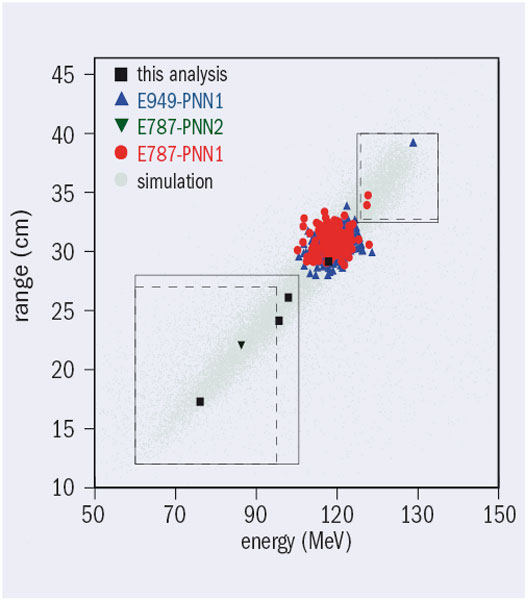The E949 collaboration at Brookhaven National Laboratory has observed three new events of the rare kaon decay K+ → π+νν. This brings the total number observed to seven, four of which were found by E949 and three by its predecessor E787. The branching ratio from all seven candidate events is (1.73 + 1.15/–1.05) × 10–10, which is consistent with the Standard Model prediction of (0.85 ± 0.07) × 10–10.

The decay, K+ → π+νν, which is one of the rarest and most challenging particle decays ever observed, is highly sensitive to physics beyond the Standard Model (SM). The uncertainty of the SM prediction, which involves second-order weak interactions – that is, the exchange of two weak force carrier bosons – is less than 10%. Any deviations uncovered by a precise measurement of this branching ratio could unambiguously signal the presence of new physics effects that are predicted in extensions to the SM.
The experimental signature for K+ → π+νν decay is the detection of a solitary positively charged pion, since the emitted neutrino and anti-neutrino pair interact too weakly to be detected, but unfortunately the sought-after signal resembles many other kaon decay channels. To identify the pion positively and ensure that no other observable decay particles were present, the collaboration created one of the most efficient particle-detection systems ever built. They also employed unbiased “blind” analysis techniques, which were pioneered by E787 and are now frequently used in modern high-energy physics experiments.
The three new events, which were obtained in a sample of 1.7 × 1012 kaon decays, were observed in a low-energy pion region (see figure). This presented an even greater experimental challenge relative to the high-energy pion region, owing to additional processes that can mimic the K+ → π+νν decay signature. The total background expected was 0.93 ± 0.17(Stat.) +0.32/–0.24(syst.) events, primarily from π+ scattering in the stopping target.
The result confirms detailed predictions of the SM at higher orders. Given the level of statistical uncertainty associated with the result, only limitations on new physics beyond the SM can be inferred. However, a new generation of K+ → π+νν measurements from the NA62 experiment at CERN aim for a precision comparable to that of the current SM prediction.
• The E949 and E787 experiments at Brookhaven’s Alternating Gradient Synchrotron included more than 100 collaborators from Canada, China, Japan, Russia and the US.
Further reading
A V Artamonov et al. 2008 Phys. Rev. Lett. 101 191802.







